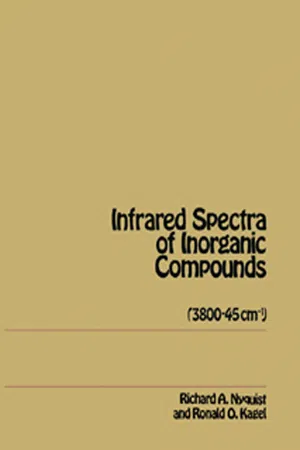Publisher Summary
This chapter discusses the experimental, theoretical, and empirical correlations between functional organic groups and the infrared spectrum. The application of infrared spectroscopy to the identification of inorganic compounds is less successful. In obtaining infrared spectra of inorganic solids, an experimental complication arises from possible chemical reaction between the inorganic compound and the infrared window material or support medium. The chapter presents many examples of spectra of inorganic compounds in the solid phase. The majority of these compounds are crystalline solids in which the crystallographic unit cell contains several polyatomic ions or molecules. Optical modes called lattice modes of vibration result from the motion of one polyatomic group relative to another within the unit cell. Lattice modes occur in the region 400–10 cm−1 and are characteristic of specific crystal geometry. They are used as fingerprints for an inorganic compound in much the same way as the internal modes of vibration of organic compounds are used in the region 4000–400 cm−1.
INTRODUCTION
The utility of infrared spectroscopy to the organic chemist is perhaps unsurpassed within the framework of most modern laboratories. Experimental, theoretical, and empirical correlations between functional organic groups and the infrared spectrum have been thoroughly studied and reported. The vast body of literature devoted to the results of these studies provides a rather solid base for use by the analytical spectroscopist. Through the efforts of several authors this accumulated literature has been summarized and reviewed in several excellent books (1–7).
The application of infrared spectroscopy to the identification of inorganic compounds has been somewhat less successful. Many simple inorganic compounds such as the borides, silicides, nitrides, and oxides, do not absorb radiation in the region between 4000 and 600 cm−1 which, for many years, was the extent of the infrared region covered by most commercial spectrometers. Only within the last 10 years have instruments become available which include the region below 600 cm−1, and it has been even more recent that instrumentation has been developed to cover the far-infrared region between 200 and 10 cm−1. These are the regions in which most inorganic compounds absorb infrared radiation.
The region 4000–600 cm−1 has proved to be very useful for the identification of polyatomic anions of the type CO32−, SO42−, NO3−, etc. When standard spectra are available, a compound such as KNO3 can easily be distinguished from NaNO3 or Ca(NO3)2, but in the absence of standard spectra, specific identification of a cation–anion pair is usually not possible by infrared spectroscopy. The differences between the spectra of KNO3 and Ca(NO3)2, for example, are largely due to two effects: (1) the extent to which the cation perturbs the internal vibrations of the anion and (2) changes in the crystal structure of the system. The latter is more pronounced in the far-infrared region than in the region 4000–600 cm−1. These effects are usually not predictable.
In obtaining infrared spectra of inorganic solids, an experimental complication arises from possible chemical reaction (cation exchange) between the inorganic compound and the infrared window material or support medium. The literature contains many examples of standard spectra of inorganic compounds in which this type of chemical reaction has obviously taken place. Care has been exercised in the preparation of samples here so as to avoid this difficulty.
In the present compendium, spectra of inorganic compounds in the solid phase are presented. The majority of these compounds are (powdered) crystalline solids in which the crystallographic unit cell may contain several polyatomic ions or molecules. The internal modes of vibration of the polyatomic group generally occur in the region 4000–400 cm−1; many of these have been extensively documented in the literature. Other optical modes called lattice modes of vibration result from the motion of one polyatomic group relative to another within the unit cell. Lattice modes generally occur in the region 400–10 cm−1 and are characteristic of a specific crystal geometry. They can be used as fingerprints for an inorganic compound in much the same way as the internal modes of vibration of organic compounds are used in the region 4000–400 cm−1. The purpose of this work is to present reference spectra and empirical spectra-structure correlations. We do not intend to cover the theoretical aspects of the solid state. For this th...
